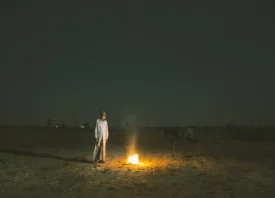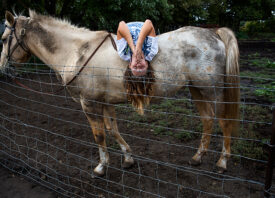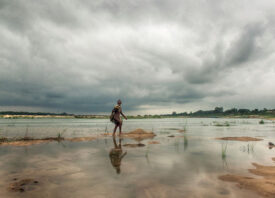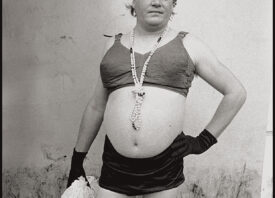Search this site
The Frontline at Standing Rock, in Photos

Water Protector at the front lines

Water Protector stands before a large group of armed police
On Monday, November 21st, 2016, photographer Avery Leigh White was struck with a rubber bullet and tear gas as police fired at the Water Protectors of the Standing Rock Reservation in Cannon Ball, North Dakota. Her hair was frozen after being drenched by a water cannon. She was unable to see, breathe, or use her hands.
“This was nothing short of a war zone,” the photographer writes, “I was terrified.”
White has been traveling to Standing Rock since October, documenting the efforts of the Water Protectors in their battle to stop the Dakota Access Pipeline, a crude oil pipeline running through 1,172-miles from the Bakken area of North Dakota into South Dakota, through Iowa, and into Illinois.
In addition to disrupting sacred Native American tribal burial ground and other ancestral markers, the pipeline could potentially pollute and contaminate the water supply of millions of citizens and accelerate climate change in the process. As a resident of New Orleans, White says the harmful actions of oil companies have long been on her radar.
When White arrived at Standing Rock, she was one of the few people recording the movement. Since then, the media presence has increased.
“The whole world is now watching,” the photographer says. In the last week, headlines on police violence against the Water Defenders, who prefer not to be called “protestors,” have proliferated. There are countless stories from those like White, who have been hit and in some cases badly injured by non-lethal weapons.
While the press helps amplify the voices of people who would otherwise remain unheard, White understands the weight of the responsibility that comes with being behind the camera.
The Water Protectors of the Oceti Sakowin encampment have given their trust to the press before, and at times that confidence has been exploited. For this reason, White makes a point of speaking with and asking permission of her subjects. Despite the cruelty she’s seen, the photographer has hope for Standing Rock. In the aftermath of the incident on November 21st, a woman took White by the hand and guided her to safety. She was given googles and an inhaler.
That same night, she remembers, “I looked into the eyes of the Water Protectors standing tall and brave, many of them praying.” She’s spent many nights with them around the Sacred Fire, listening to them sing.
When asked what she takes away from her time at Standing Rock, White says simply, “I learned that taking action against injustice by linking arms with your fellow man and defending the sacred are some of the only things worth living for.”
Follow White on Instagram to see how the story unfolds in the wake of yesterday’s decision by the Army Corps of Engineers.

A storm is coming

Brown Beret member rests at Oceti Sacowin camp

Main resistance camp Oceti Sacowin as the sun sets

Manuelita volunteers with the Standing Rock Legal Collective

Oceti Sacowin camp

Police shoot water and tear gas into the crowd

Water Protector helps winterize the camp

Water Protectors perform a ceremony at the front lines

Water Defender gifts spiritual plants at front lines

Water Defender shields herself from rubber bullets and tear gas

Water Defenders being hit by water cannons

Water Protector at the front lines

Young Lakota woman cries at the front lines

US Vet rides through camp as the sun sets
All images © Avery White



